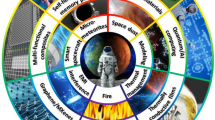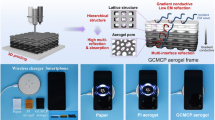Abstract
Multilayer insulation (MLI) technique has provided a reliable thermal protection mechanism for cryostat’s cold wall boundary against the ambient heat load, in particular, the thermal radiation heat load. The aim of the current work is to attain an improved thermal performance from MLI technique by scrutinizing its insulation potential in terms of the heat load. The intervening medium in this investigation is made up of three suitable spacer and radiation shield materials: perforated Double Aluminized Mylar (DAM) with Dacron, perforated DAM with Glass−tissue, and unperforated DAM with Silk−net. The thermal performance of MLI system is evaluated by exploring the impact of associated physical parameters such as emissivity and residual gas pressure, geometry of the radiation shields (perforation styles of radiation shields), and analyzing the effect of the radiation shield’s arrangement on the heat load. We have observed that for perforated DAM with Dacron, the radiation heat load is the lowest. A medium vacuum level < 0.01 Torr, perforation style PS\(_{\mathrm {A}}\) in the radiation shield (in low−temperature region), and positioning radiation shields with decreasing spacing from the cold to hot wall boundary region facilitates a significant reduction in the heat load.










Similar content being viewed by others
Notes
Radiation shields are typically comprised of thin (paper−like) polyethylene or Mylar sheet reflecting layers, leading to a great number of such layers between the cold and hot wall boundaries. These reflective layers are usually coated with Aluminium (also Gold or Silver) on both sides to attain a high reflecting performance value [44]. Frequently utilized radiation shields in MLI technique are Double Aluminized Kapton [40], Double Aluminized Mylar (DAM) [9] and Aluminium foils [44], etc. There are many spacers used in various MLI performances like Nomex [40], Carbon fibrous, Alumina fibrous [5], Dacron, Glass−tissue, Silk−net [27], Refrasil [44], etc.
References
Weisend JG II (ed) (2016) Cryostat design: case studies, principles and engineering. Springer International Publishing, Cham, Switzerland, pp 1–45
Hooks J, Demko JA, Fesmire JE, Matsumoto T (2017) IOP Conf Ser Mater Sci Eng 278:012199
Angloher G, The EURECA Collaboration et al (2014) Phys Dark Universe 3:41
Johnson WL (2012) AIP Conf Proc 1434:1519; McIntosh GE, McIntosh RC (2020) IOP Conf Ser Mater Sci Eng 755:012001
Chen MJ, Zhang P, Li Q (2018) Sci China Tech Sci 61:994; Jiang WB, Zuo ZQ, Huang YH, Wang B, Sun PJ, Li P (2018) Cryogenics 96:90; Mazzinghi A, Sabbadini M, Freni A (2018) Sci. Rep 8:91
Sutheesh PM, Chollackal A (2018) IOP Conf Ser Mater Sci Eng 396:012061
McFarland C, Agarwal RK (2022) Mechanical Engineering and Materials Science Independent Study 176
Gogu C, Bapanapalli SK, Haftka RT, Sankar BV (2009) J Spacecr Rocket 46:501
Singh D, Pandey A, Singh MK, Singh L, Singh V (2020) JINST 15:P07032
Nast TC, Frank DJ, Feller J (2014) Cryogenics 64:105; Ding W, Zhou Y, Gu M, Gong J, Xu J (2022) Energies 15:4831
Baudouy B (2014) CERN-2014-005. CERN Geneva, Switzerland, pp 329
Kumar S (2016) J Therm Sci Eng Appl 8:021003
Lacerda G, Curi M (2020) Revista de Engenharia Térmica 19(2):70; Mzad H, Haouam A (2020) Progress in Superconductivity and Cryogenics 22(1):17
Ji T, Zhang R, Sunden B, Xie G (2014) Appl Therm Eng 70(1):957; Deng B, Yang S, Xie X, Wang Y, Bian X, Gong L, Li Q (2019) Cryogenics 100:114
Chen M, Li Q, Zhang P (2022) Appl Therm Eng 210:118318
Barabanov I et al (2009) Nucl Instrum Methods Phys Res A 606:790
Elchert JP (2018) Thermal and Fluids Analysis Workshop (TFAWS) 20
Hedayat A et al (2000) 36th AIAA/ASME/SAE/ASEE Joint Propulsion Conference and Exhibit
Fesmire J, Johnson W (2018) Cryogenics 89:58
Cunnington GR et al (1971) Interim report LMSC-A903316/NASA CR-72605, Lockheed Missile and Space Company, Sunnyvale, CA, U.S.A.
Wang B, Huang YH, Li P, Sun PJ, Chen ZC, Wu JY (2016) Cryogenics 80:154
Ross RG Jr, Boyle RF (2006) International Cryocooler Conference Annapolis
Li P, Cheng H (2006) Appl Therm Eng 26
Keller CW, Cunnington GR, Glassford AP (1974) NASA Contractor Report 134477
Johnson WL (2007) Thermal performance of cryogenic multilayer insulation at various layer spacings. Master thesis, Auburn University
Johnson WL, Frank DJ, Nast TC, Fesmire JE (2015) IOP Conf Ser Mater Sci Eng 101:012018
McIntosh GE (1994) Adv Cryog Eng 39B:1683
McIntosh GE (1994) In: Kittel P (ed) Advances in Cryogenic Engineering. Springer, Boston, MA, pp 39
Lucie M, Veronika M, Josef S, Oldrich Z (2019) Mater Sci Forum 955:25
Borst M (2020) Mass optimisation of cryogenic fluid systems for long-duration space missions. Master thesis, Delft University of Technology
Johnson WL (2010) AIP Conf Proc 1218:804
Mazzone L et al (2002) European organization for Nuclear research, Laboratory for Particle Physics. Divisional Report, CERN LHC/2002-18 (ECR)
Agostini M et al (2014) Eur Phys J C 74:2764
Parma V (2013) Cryostat Design, CERN Yellow Report, CERN-2014-005, vol 353
Godfrin H (2011) European Advanced Cryogenics School-Chichilianne
Teodorescu G (2007) Radiative emissivity of metals and oxidized metals at high temperature. PhD thesis, Auburn University
Kaufman JG (2016) ASM International 138
Geyari C, Pundak N (1971) Vacuum 21:413
Johnson WL (2009) Cryogenics Test Laboratory 321:867
Sun PJ, Wu JY, Zhang P, Xu L, Jiang ML (2009) Cryogenics 49:719
Abgrall N, LEGEND Collaboration et al (2021) Preprint at https://arxiv.org/abs/2107.11462
Albert JB, nEXO Collaboration et al (2018) Phys Rev C 97:065503
Fesmire JE, Augustynowicz SD, Rouanet S (2008) AIP Conf Proc 985:1359
Cunnington GR Jr, Zierman CA, Funai AI, Lindahn A (1967) NASA Contract Rep 907
Acknowledgements
The author D. Singh sincerely acknowledges Council of Scientific and Industrial Research (CSIR−UGC), New Delhi, India, for the financial support in the form of CSIR (JRF/SRF) fellowship. The authors D. Singh and V. Singh are grateful to the Ministry of Human Resource Development (MHRD), New Delhi, India for the financial support through Scheme for Promotion of Academic and Research Collaboration (SPARC) project No. SPARC/2018−2019/P242/SL.
Author information
Authors and Affiliations
Corresponding author
Ethics declarations
Conflicts of interest
The authors declare that they have no conflict of interest.
Additional information
Publisher’s Note
Springer Nature remains neutral with regard to jurisdictional claims in published maps and institutional affiliations.
Rights and permissions
Springer Nature or its licensor (e.g. a society or other partner) holds exclusive rights to this article under a publishing agreement with the author(s) or other rightsholder(s); author self-archiving of the accepted manuscript version of this article is solely governed by the terms of such publishing agreement and applicable law.
About this article
Cite this article
Singh, D., Singh, M.K., Chaubey, A. et al. Thermal performance improvement of multilayer insulation technique. Heat Mass Transfer 59, 1365–1378 (2023). https://doi.org/10.1007/s00231-022-03330-y
Received:
Accepted:
Published:
Issue Date:
DOI: https://doi.org/10.1007/s00231-022-03330-y




